
Bichelsee is a village and former municipality in the canton of Thurgau, Switzerland. It takes its name from the nearby lake, Bichelsee.
Contents
The municipality also contained the villages Höfli, Niederhofen am Bichelsee and Itaslen.

Bichelsee is a village and former municipality in the canton of Thurgau, Switzerland. It takes its name from the nearby lake, Bichelsee.
The municipality also contained the villages Höfli, Niederhofen am Bichelsee and Itaslen.
Bichelsee is first mentioned in 894 as Pichelense. [1] The Udalrichinger family donated the village of Bichelsee, in the Early Middle Ages, to the Abbey of St. Gallen. During the High Middle Ages, the Bichelsee family ruled the village as a fief for the Abbey. Originally they ruled from Alt-Bichelsee Castle, though in the early 13th century, they built Neu-Bichelsee Castle. This castle was destroyed in 1274 by the Habsburgs. In 1358 Hermann IV of Landsberg-Greifensee acquired Alt-Bichelsee Castle along with various rights and possessions, including the bailiwick of Balterswil. In 1407, Alt-Bichelsee was burned by Appenzell troops. After rebuilding the castle, the Abbey of Fischingen bought the castle, land and parish in 1419–21. It remained part of the Fischingen court until 1798. However, the village of Itaslen was not part of Bichelsee at this time. It was part of the Tannegg district and an independent municipality until 1812. [1]
The parish church of St. Nicholas (later St. Blasius church) was occupied from 1275 and probably built in the 12th century under the leadership of Fischingen Abbey. The Abbey supported the church until 1769. In 1529 the village converted to the new faith during the Protestant Reformation in 1529, but returned to their old faith in 1542 during the Counter-Reformation. The Reformed church members were part of the parish of Dussnang since 1550. St. Blasius church remained a shared church, even after a new church was built in 1864, until 1954. In 1960 a new Reformed church was built. [1]
Agriculture and small industries still dominated the local economy until the late 20th century. Since the end of the 19th century, cropland and orchards have been segregated from the dairy industry. Small-scale home weaving and embroidery became common in the early 19th century but declined by about 1900. In 1899, Johann Evangelist Traber founded the first Swiss Raiffeisen bank. The largest employer is the Traxler AG embroidery firm (founded 1908). With increased immigration after 1970 and the construction of many new houses, it became a commuter town; by 1990, about 62% of the population commuted. [1]
In 1996 the municipality was merged with the neighboring municipality Balterswil to form a new and larger municipality Bichelsee-Balterswil. [2]
The historical population is given in the following table: [1]
| Year | Population, Bichelsee Village | Population, Bichelsee Bürgergemeinde |
|---|---|---|
| 1850 | - | 1,071 |
| 1870 | 605 | 953 |
| 1900 | 728 | 1,205 |
| 1910 | 782 | 1,442 |
| 1950 | 691 | 1,417 |
| 1970 | 696 | 1,554 |
| 1990 | 935 | 2,065 |
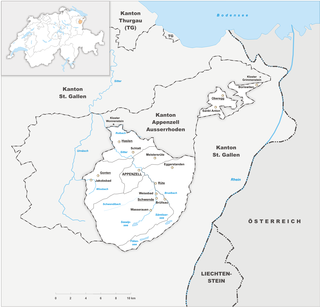
Appenzell Innerrhoden, in English sometimes Appenzell Inner-Rhodes, is one of the 26 cantons forming the Swiss Confederation. It is composed of six districts. The seat of the government and parliament is Appenzell. It is traditionally considered a "half-canton", the other half being Appenzell Ausserrhoden.

Appenzell Ausserrhoden, in English sometimes Appenzell Outer Rhodes, is one of the 26 cantons forming the Swiss Confederation. It is composed of twenty municipalities. The seat of the government and parliament is Herisau, and the seat of judicial authorities are in Trogen. It is traditionally considered a "half-canton", the other half being Appenzell Innerrhoden.

Appenzell was a canton in the northeast of Switzerland, and entirely surrounded by the canton of St. Gallen, in existence from 1403 to 1597.

Fischingen Abbey, now Fischingen Priory, is a Benedictine monastery situated in Fischingen in the Canton of Thurgau, Switzerland, on the upper reaches of the Murg, a tributary of the Thur. It was founded in 1138, dissolved in 1848 and re-founded as a priory in 1977.

Frauenkappelen is a municipality in the Bern-Mittelland administrative district in the canton of Bern in Switzerland.

Amlikon-Bissegg is a municipality in the district of Weinfelden in the canton of Thurgau in Switzerland.

Bichelsee-Balterswil is a municipality in the district of Münchwilen in the canton of Thurgau in Switzerland. It was formed from the union on January 1, 1996 of Bichelsee and Balterswil.

Fischingen is a municipality in the district of Münchwilen in the canton of Thurgau in Switzerland.

Lommis is a municipality in the district of Münchwilen in the canton of Thurgau in Switzerland.
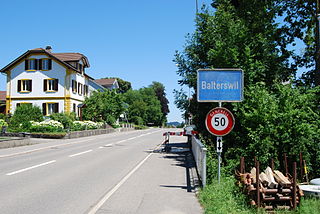
Balterswil is a village and former municipality in the canton of Thurgau, Switzerland. The municipality also contained the villages Lützelmurg, Zielwies, Ifwil and Lochwies.
Griesenberg is a village and former municipality in the canton of Thurgau, Switzerland.

Basadingen is a village and former municipality in the canton of Thurgau, Switzerland.

St. John's Abbey in the Thurtal was a Benedictine monastery originally established in Alt St. Johann in the Canton of St. Gallen, Switzerland, in the mid-12th century.
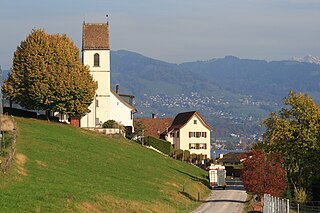
Bollingen is a village (Kirchdorf) within the municipality of Rapperswil-Jona in the Swiss canton of St. Gallen.

Busskirch is a village (Kirchdorf) within the municipality of Rapperswil-Jona in the canton of St. Gallen, Switzerland.

Glarus Nord is one of three municipalities of the canton of Glarus, Switzerland.
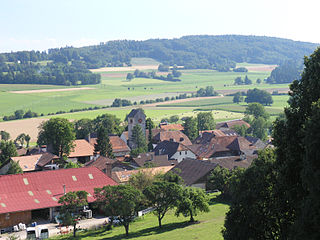
Plateau de Diesse is a municipality in the Jura bernois administrative district in the canton of Bern in Switzerland, located in the French-speaking Bernese Jura. On 1 January 2014 the former municipalities of Diesse, Lamboing and Prêles merged into the municipality of Plateau de Diesse.

Münster is one of the two main churches of the old town of the Swiss city of Schaffhausen. First built in 1064 AD as a Romanesque Basilica of the then Benecdictine Kloster Allerheiligen, it was rebuilt several times, and became in 1524 the Reformed Church of the city of Schaffhausen.
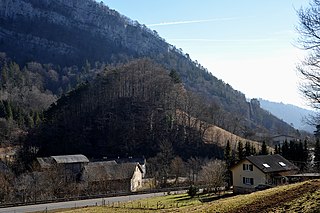
Péry-La Heutte is a municipality in the Jura bernois administrative district in the canton of Bern in Switzerland. It is located in the French-speaking Bernese Jura. On 1 January 2015, the former municipalities of Péry and La Heutte merged to form the new municipality of Péry-La Heutte.
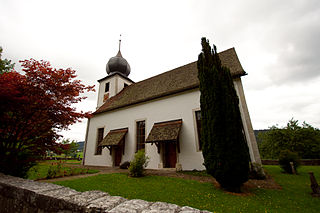
Petit-Val is a municipality in the Jura bernois administrative district in the canton of Bern in Switzerland. It is located in the French-speaking Bernese Jura. On 1 January 2015 the former municipalities of Châtelat, Monible, Sornetan and Souboz merged to form the new municipality of Petit-Val.
47°27′N8°56′E / 47.450°N 8.933°E